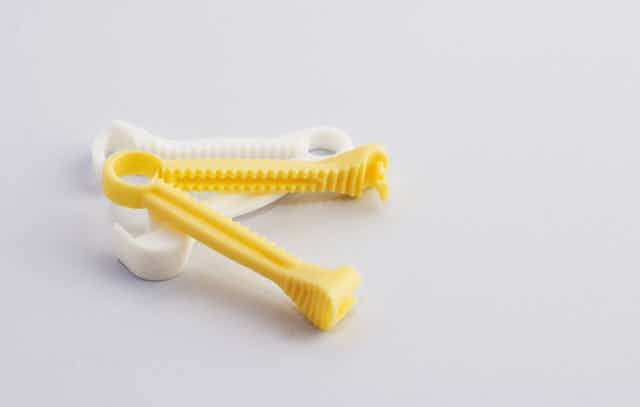Clamping and cutting a baby’s umbilical cord as soon as it is born can be bad for its health. The World Health Organisation advises that clamping should be delayed for two to three minutes after the baby has been born, and the UK watchdog NICE advices midwives and obstetricians not to clamp the cord earlier than one minute after the birth. But in nearly a third of cases, this doesn’t appear to be happening.
In a survey of 3,500 parents whose children were born in the UK between 2015 and 2017, 31% said that their baby’s cord was clamped less than a minute after they were born. One in five said that their baby’s cord was cut immediately following the birth.
Life support
The umbilical cord consists of a vein and two arteries, which are surrounded by a gelatinous substance called Wharton’s jelly. A membrane, called the amnion, holds the whole thing together.
During pregnancy, the umbilical cord vein carries oxygen-rich blood and nutrients from the placenta to the baby, and the arteries return deoxygenated blood and waste products, such as carbon dioxide, to the placenta.
A baby’s blood supply is independent of its mother’s, and remains within this closed circuit throughout pregnancy, labour and birth. As the baby is squeezed through the birth canal or an abdominal incision (if it’s a caesarean birth), a lot of the baby’s blood is pushed back into the placenta. But as the baby emerges, the umbilical cord – if left to pulsate – returns all of this blood to its rightful owner in a few minutes.
The cord continues to act as the baby’s only oxygen supply until the baby starts to breathe, before the placenta becomes detached. So, even when a baby needs help to breathe, the cord should ideally remain intact as the baby is resuscitated at the bedside. If the umbilical cord is cut too early, the baby can be deprived of oxygen, 20-30% of its blood volume and 50% of its red blood cell volume.

This shortage of blood will leave up to 30% of babies with iron-deficient anaemia. A review of 27 studies involving six to 24-month-old babies found that babies with iron-deficient anaemia have significantly poorer brain, physical, social and emotional functioning. Iron deficiency has also been linked to recurring infections, autism and learning difficulties.
A few minutes makes a big difference
Aside from reducing the risk of iron-deficiency anaemia, delaying clamping by a few minutes has a range of other health benefits, including: a reduced lifetime risk of developing chronic lung disease, asthma, diabetes, epilepsy, cerebral palsy, Parkinson’s disease, infection and abnormal tissue growths; a reduced risk of bowel infections, death in premature babies,sepsis and brain haemorrhage in very premature babies; and an increased likelihood of being more sociable and better behaved at age four.
Babies who have delayed cord clamping also enjoy higher birth weights, compared with babies who have their cords clamped immediately.
Ultimately, immediate cord clamping disrupts the natural birth process and may cause harm to some babies by depriving them of essential blood and stem cells. Waiting until the umbilical cord is empty of blood before clamping it is the way to go.

